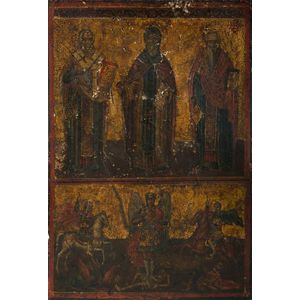Regency Nautical Trumeau Mirror
You must be a subscriber, and be logged in to view price and dealer details.
Subscribe Now to view actual auction price for this item
When you subscribe, you have the option of setting the currency in which to display prices to $Au, $US, $NZ or Stg.
- Mahogany - Mahogany is a dense, close grained red-coloured timber from the West Indies and Central America. It was first imported into Europe in the the early 18th century and its use continued through the 19th century. It was popular for furniture making because of its strength, the wide boards available, the distinctive grain on some boards, termed flame mahogany and the rich warm colour of the timber when it was polished.. The "flame" was produced where a limb grew out from the trunk of the tree, and this timber was usually sliced into veneers for feature panels on doors, backs and cornices.
Some terms used to describe mahogany relate to the country from which it originally came, such as "Cuban" mahogany, "Honduras" mahogany etc. However unless the wood has been tested the names assigned are more a selling feature, rather than a true indication of the timber's origin. - Giltwood - Giltwood is used to describe a gold finish on furniture and other decorative wooden items, whereby a thin sheet of gold metal, called gold leaf, is applied to the surface for decorative purposes.
Unlike gilding, where the gold leaf is applied over a coating of gesso, with giltwood the gold leaf is applied direct to the surface, or over a coat of linseed oil gold leaf adhesive.
Most gold-finished mirrors will be gilded, whereas furniture with gold highlights will have the gold applied through the giltwood method. - Regency Period - The Regency period in English furniture design refers to the period when King George III, was declared unfit to rule in 1811, and his son ruled as proxy as Prince Regent, until 1820, and then, after the death of his father as George IV until his death in 1830. The Regency period was preceded by the Georgian period (George I, George II, and George III: 1714 - 1811), and was followed by the William IV period, which only lasted until 1837 when William IV died as was succeeded by Queen Victoria.
- Trumeau - A trumeau mirror is usually rectangular in shape, with a decorative painted panel above the mirror. Most antique trumeau mirrors are highly ornate and often gilded.
They were originally manufactured in France in the 18th century, but became popular agina in the Regency period and in the 1950's.
Trumeau mirrors were originally intended to hang on a wall between windows, providing a decorative element and bringing more light to the room.
This item has been included into following indexes:
- mirrors, wall, period, age or style
- trumeau (wall mirrors) 54
Visually similar items

A Russian icon, three holy Hierarchs, 19th century, housed in gilt wood frame, 59 x 48 cm

Alex de Andreis (1880 - 1929) The Red Cardinal, oil on canvas, signed & dated lower right 1924, 64 x 80 cm

19th century Grand Tour watercolour European landscape in ornate gilt frame

Early Greek Orthodox icon. two sections including three saints above; and angel flanked by knights slaying dragon etc. To lower, gilt and tempera on wood panel, 48 x 33 cm
